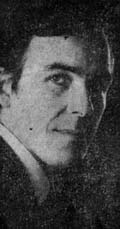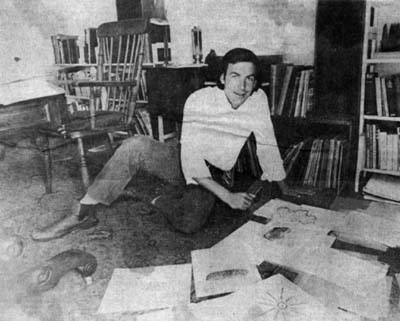The man who 'cracked the Newgrange code'
Sunday Press - 12 August 1979Horizons - Presented by Ginnie Kennealy
 The
text books will have to be re-written in October, when Martin
Brennan's The
Boyne Valley Vision is published in Dublin. Or if not in
October, then just as soon as the pros of the archaeological
establishment have digested his shattering discoveries, attempted
to fault them, and failed.
The
text books will have to be re-written in October, when Martin
Brennan's The
Boyne Valley Vision is published in Dublin. Or if not in
October, then just as soon as the pros of the archaeological
establishment have digested his shattering discoveries, attempted
to fault them, and failed.
This, at any rate, is the belief of 37-year-old Martin Brennan, a graphic designer born of Irish parents in New York, and resident in Dublin for the past ten years. He claims to have deciphered the secret language of Newgrange, thus demonstrating that stone age man in Ireland was no primitive, but an astronomer so advanced that some of his discoveries have only seen confirmed since we sent satellites into space.
"We've really cracked the code," he told me, understandable elated, in his top floor flat in Dublin's Fitzwilliam Street. "I believe it's the archaeological find of the age more important even than the Rosetta stone in Egypt."
Breakthrough
Martin Brennan has been working on the Newgrange mystery for over three years, but it was only at Easter this year that he made his big break through the one which really opened up the mind of megalithic man, allowing Brennan to read his strange spirals and Zig-Zags at Newgrange like an open book."It's so simple you kick yourself for not seeing it before," says Brennan. "If I had been a trained archaeologist or astronomer I would never have got it at all. Being trained to look at things visually, I was able to see the signs more as they would have been seen by people of 3,500 BC; and that's what led me to it."
Even so, all that he grasped up to Easter this year was the symbolic meaning of the carvings. After trying the techniques of cryptologists down to the code-breakers of World War II, he eventually stumbled on the secret. Then over a period of five days he unearthed such a wealth of information that it could fill a whole book on its own.
Astronomy
"No one's really prepared for the magnitude of what I've found. My mind is still almost drunk at the scale of it," Brennan says. "I thought I wasn't underestimating stone age man, just as Gerald Hawking, who discovered that Stonehenge could have been used as an astronomical clock, though that he wasn't But we both were."The word "revolutionary" is a big one, and should not, Martin Brennan believes, be used irresponsibly. Thus he agrees that his findings are going along the lines prepared in the last century by Sir Borman Lockyer and earlier in this one by Prof. Alexander Thom, both of whom point to advanced astronomical skills in megalithic man, and suggest that their mathematical knowledge pre-dated the Egyptians. "The idea of megalithic mounds being related to astronomy is not new," he says "but the level of efficiency and the depth of the calculations I have discovered are quite shattering. I even have the equipment and tools with which they made their geometric calculations and the navigational instruments they used to get to the Canaries."
Copernican
What are truly revolutionary, Brennan believes, are the historical implications of his findings. They mean that the whole idea of the primacy of the Egyptian and Babylonian cultures as the cradle of civilisation and mathematics goes out the window.It changes the ancient centre of the world from the Middle East to Ireland-or at least to the fringes of Western Europe," he claims. "This is like the Copernican revolution, when men had to adjust their minds to the idea of the earth going round the sun."
How does Martin Brennan believe that stone age man came by his advanced knowledge?
"Simply by thousands of years of observation of the moon and the stars and the sun," he says. "These were things that affected him very closely. I have traced it back to the cavemen of the ice age, whose major worry was to escape the attentions of the famished cave bears who hunted them for food. By putting strokes on the wall of the cave or notches on a piece of bone to record the waxing and waning of the moon, they could work out when the bears would be coming out of hibernation.
Not fanciful
"Then when the ice receded and they started to develop agriculture, the observation of the sun's solstices and equinoxes as well as the phrases of the moon became vital for the timing of sowing and reaping."The amazing thing is, however, that these people took their astronomy much further than would have been necessary for mere prediction of the season. Yet Martin Brennan is not tempted into any fanciful explanation or conjuring up of demi-gods from the lost continent of Atlantis, as some researchers in this field would be.
"Over the time period concerned, I think it highly likely that megalithic man threw up a genius of the statue of Newton or Einstein, who developed their mathematics out of sheer love of the intellectual chase," he says. "And once you have one genius, his system can be maintained.
But while I believe that the men of Newgrange were so advanced that they even had the golden section and the 2,500 year equinoctial cycle before the Greeks, I don't think they actually used numbers, and in that I differ from a lot of students of the period.
No numbers
"I believe they did it all visually. You don't need numbers for their kind of geometry in action. And they didn't need numbers, either for their type of civilisation, which had no real concept of personal property and therefore no need for divisions into fractions".Martin Brennan first became interested in Newgrange and the other sites of the Boyne Valley not from an archaeological or astronomic point of view, but from his interest in prehistoric religion and art. And it's remarkable, he says, how art, religion and science all merge in the achievements and pursuits of megalithic man. However he realises that given his background his discoveries may at first be dismissed as the ravings of an amateur.
"I don't really expect the archaeologists to take me seriously to begin with," he says. "They'd naturally feel that I could have nothing to say, not being professional. But when they see what I've got they'll just have to sit up and take notice, even though my discoveries will mean throwing a good many accepted archaeological ideas out the window.
Sun and moon
"I'm sure that Newgrange was not originally built as a burial site although later on it came to be used as one. It is most deliberately aligned not only to the rising sun at the winter solstice, as is generally known, but to the moon at certain periods, when the rising moon fills the whole chamber with silver light.So I'm sure the mound's primary purpose was astronomical. The whole game is to harmonise the sun and the moon, and I started my research at the site three years ago where the other astronomical researcher left off."
But Martin Brennan's discoveries go further than the simple atronomical. By cracking the code of the Newgrange inscriptions he believes that he has made it possible for us to read the secret language of all the megalithic sites in Europe, in the Canary Islands, and possibly further afield as well. He is particularly interested in Mexico and Japan.
So from October on, when he is due to become a world celebrity, it seems unlikely that Martin Brennan will have time for anything but work on his next book and the next stages of the research. At present he works as graphic designer and teaches aikido, the Japanese martial art, in his spare time. Such activities, no doubt, will come to an end.

Martin Brennan with some of the graphics which will feature in his book The Boyne Valley Vision. Picture - Pat Cashman.
Boyne Valley Private Day Tour
 Immerse yourself in the rich heritage and culture of the Boyne Valley with our full-day private tours.
Visit Newgrange World Heritage site, explore the Hill of Slane, where Saint Patrick famously lit the Paschal fire.
Discover the Hill of Tara, the ancient seat of power for the High Kings of Ireland.
Book Now
Immerse yourself in the rich heritage and culture of the Boyne Valley with our full-day private tours.
Visit Newgrange World Heritage site, explore the Hill of Slane, where Saint Patrick famously lit the Paschal fire.
Discover the Hill of Tara, the ancient seat of power for the High Kings of Ireland.
Book Now
Home
| Visitor Centre
| Tours
| Winter Solstice
| Solstice Lottery
| Images
| Local Area
| News
| Knowth
| Dowth
| Articles
| Art
| Books
| Directions
| Accommodation
| Contact

